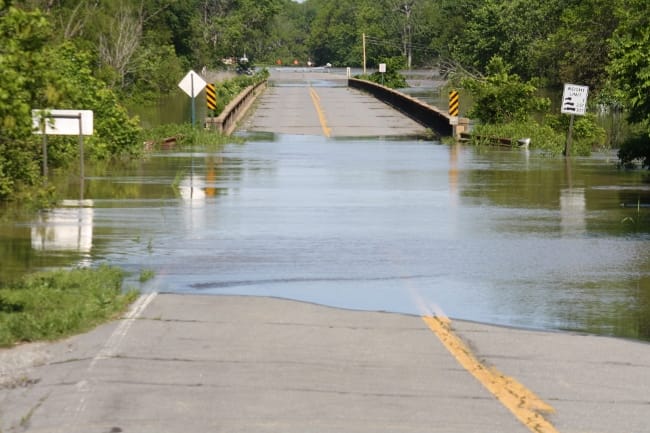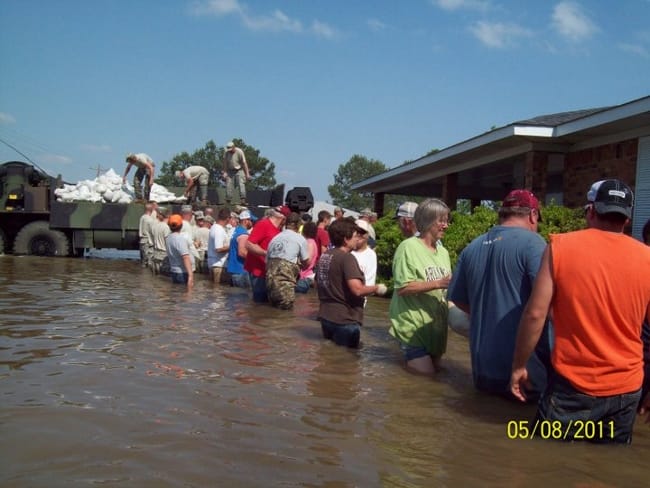

Uh oh...
It appears that you're using a severely outdated version of Safari on Windows. Many features won't work correctly, and functionality can't be guaranteed. Please try viewing this website in Edge, Mozilla, Chrome, or another modern browser. Sorry for any inconvenience this may have caused!
Read More about this safari issue.

“It was the worst experience of my life,” said Prairie County Judge Mike Skarda, about the record-breaking flood that hit his county five years ago. Prairie County is a small county which includes the cities of Des Arc, Hazen, DeValls Bluff and surrounding areas. Judge Skarda has lived in Des Arc his entire life and presided as county judge for the last nine years, but the flood of 2011 was an event like none before or since.
“I’ve never experienced anything that bad because there were people who needed help, and there was nothing I could do,” he said. “There’s nothing worse than having a little old lady come up and put her arm around you and say she’s lost everything.”

But similar stories of loss and devastation rippled throughout the county, one after the other. When the White River crested at 39.43 feet May 7, 2011, 279 homes had been damaged or completely lost. And every resident of this small, closely-knit county felt the effects in some way or another.


Photos courtesy of Kimberly Parchman
The Flood was the result of a conglomeration of events, the culmination of a “perfect storm.” Record rainfall in Southern Missouri and Northern Arkansas in late April meant the dams in those areas were full and any further accumulation had to be released. The water released from the dams, along with water from the Strawberry, Buffalo and Black Rivers all eventually reached the White River, which was forecast to crest at 36.43 feet May 4. However, more than 9 inches of rain fell north of Prairie County in a 36-hour period, and this extra rainfall led to the unprecedented crest May 7.

With the waters suddenly reaching 3 feet higher than predicted, most residents had little warning or time to evacuate their homes. Christy Bell, a former resident of the Spring Lake community near Des Arc, said her family had just one morning to get their things out. “We were told we needed to prepare to move out. The next day we started packing, and by noon they said we had to go.” Christy said her family was able to remove most furniture and a few clothes, but that was about it. “I lost all my kids’ mementos, baby books, picture albums from high school, etc.” she said.

North on Hwy. 11, Mike and Donna McIntosh were rushing to evacuate their home as well. Initially, they hadn’t been worried because their home had been there since the late sixties and never flooded. They had a scare in 2008 when the floodwaters reached 33.78 feet, but sandbagging around the house had kept the water out. This time around, the McIntoshes hoped for the same fate. With a lot of help from volunteers, they sandbagged the perimeter of their home and prayed for the best. As the water rose, they sandbagged higher. They also began setting their furniture on concrete blocks inside the house but had no intention of moving out. Donna recalls going into town to take a break from the work and an alarmed friend telling her they had to get out now. The water was continuing to rise. So the couple, along with family and friends, got to work loading their furniture and personal belongings into cattle trailers and moving it to higher ground. The water ended up getting 5 feet deep inside the house and stayed there for two weeks.
Hundreds of others across the county had similar stories. Home after home and memory after memory was lost in the devastating flood. Yet many too were saved, thanks to the diligence and tireless efforts of countless volunteers. The waters brought with them waves of servants from within Prairie County and beyond who came to give of their time and fill sandbags, move furniture, cook meals and more.
“I was so proud of Prairie County,” Judge Skarda said. He recalls working Friday, the day before the crest, and seeing a Hazen High School bus full of football players, cheerleaders and other students pull up. They had come to volunteer. “It put tears in my eyes,” he said. “You know we hate Hazen,” Skarda joked about his town’s rival school, “but everybody treated everybody as equal. It didn’t matter who you were. It was awful but it was something that brought people together. There wasn’t any more northern and southern district of the county. It was Prairie County.”

One victory that was a direct result of volunteer efforts was the home of Russell and Cheryl Petty in DeValls Bluff. With the help of around 100 volunteers, including family, friends and strangers, Russell built a giant levy and moat all the way around his three-bedroom home. Without asking them to, volunteers showed up to sandbag and evacuate all furniture from his home, just in case. The New York Times even caught wind of the giant effort and sent a reporter to cover the story, which spread to news outlets around the country. “I overworked a lot of good men. It was hard and humbling,” Petty said in the Times. But the work was successful and the Pettys ultimately saved their home, which was without flood insurance.


In the weeks and months that followed, the need to “love your neighbor” continued. And that’s just what the people of Prairie County did. Churches, community centers and relatives housed displaced families as they slowly but surely got back on their feet. The government and the Red Cross reached out to help as well. According to Sandra Patterson, Prairie County Emergency Manager, FEMA provided some families money similar to unemployment because they were unable to travel to work. They also provided around 10-12 trailers to temporarily house some families. Approximately half the families whose homes were damaged did not have flood insurance, she said.
Now five years later, Judge Skarda says his county has mostly recovered. “The physical stuff we’ve recovered from. We’ve rebuilt the roads and cleaned up the mess from the disaster. We’ve gotten all that accomplished,” he said. The memories, though, live on. “People don’t ever get over that, but I’m not sure you should get over it.”
Most of the families affected are now comfortably settled in new homes. Either they moved into town, away from the flood zone, or they rebuilt and raised their elevation. With the help of flood insurance, the McIntoshes gutted their house but lifted the frame and rebuilt 8 feet off the ground. Donna said she and her husband considered moving to nearby Searcy, where he works, but decided against it. “I’ve lived here all my life. I don’t really want to move anywhere,” she said. Nearly everyone who lost their homes in the flood decided the same and stayed in the county.

Judge Skarda said the lesson everyone can take from this harrowing experience is to “always be prepared.” He and his staff have worked hard to do that. He is in the process of petitioning the federal government for more drainage, and he now uses social media to quickly spread the word about flood water levels. Patterson also said they have changed the elevation requirements for homes built in the flood zone, requiring them built at 199.2 feet, 2 feet above the base flood elevation.
Though they lost much and were forced to purchase a new home, Bell said she is thankful the flood was not a violent situation and her family was safe. The lesson she said she learned is a universal one that serves everyone: “You can always replace material things.”
Header photo courtesy of Jimmy Rollins.
Join the Conversation
Leave a Comment
One response to “Prairie County Commemorates Five Years Since Historic Flood”
 Leave a Reply
Leave a Reply
We do the work.
You check your email.
Sign up for our weekly e-news.
Get stories sent straight to your inbox!












 Leave a Reply
Leave a Reply
[…] experienced catastrophic flooding in Prairie County in 2011, along the Arkansas River in 2019 and throughout southeastern Arkansas in early 2021. Fortunately, […]